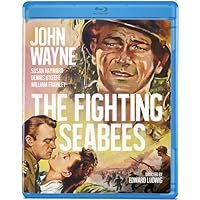 This movie provides one telling of their story. During WWII, there was a serious need for men in the military who had the know how and the determination to carry out essential construction work, particularly in the Pacific Theatre of operations.
This movie provides one telling of their story. During WWII, there was a serious need for men in the military who had the know how and the determination to carry out essential construction work, particularly in the Pacific Theatre of operations.In this movie we learn a bit about the plan and recruitment of men to serve as hybrid construction workers/soldiers. John Wayne was a natural choice to serve as the prototypical SeaBee -an undisciplined individual, but determined, willing and able.
Join JW and his colleagues as they work and fight their way across the Pacific, building runways and roads, and anything else that needed to be made. During their spare time, they did some fighting, and JW finds time for some romancing (doesn't he usually?).
A good telling, and an interesting movie, but not quite 5-star material. Well worth a watch though!This movie has become a part of lore among the men and women of the finest combat contstruction organizations of the US military. It is a nice Hollywood adaptation of the creation of the US Navy Seabees. And who can forget the best character in the movie -Natasha! It's not often that you see JW's character make the ultimate sacrifice. I watch this and see the beginning of some traditions and attitudes still in practice today. "With Compassion for Others, We Build We Fight, for Peace with Freedom," from the Seabee Museum. Remember their montra: Seabee Can-Do.
Buy The Fighting Seabees (1944) Now
In one of his lesser starring efforts, John Wayne plays the leader of a construction company that goes on to help form the Fighting Seabees, an armed group of workers. Prior to the Seabees, the construction crews building air strips and other military installations weren't allowed to carry arms. Wayne is stubborn and determined to say the least, and he pushes to have his men armed for battle as they work on curiously named islands in the Pacific during the Second World War. The film's focus is torn between the establishment of the Seabees and Wayne's romance with journalist Susan Hayward. Neither plotline is developed enough, and considering that it appears to be a war film, there's not much to the fighting in the film. It's not a bad film, but it suffers from a low budget and a script that needed much more work. However, there is a rare chance in this film to Big John jitterbug, which is good for a laugh.Read Best Reviews of The Fighting Seabees (1944) Here
The setting of this movie is an island in the Pacific in June 1942. Besides getting entertained by the blazing combat action and the fervid patriotic mood, the viewer gets an education on the Seabees. The term itself comes from a phonetization and dramatization of CB's, which stands for Construction Battalions.Wedge Donovan (a young John Wayne) takes command of a US Navy group of engineers who are using bulldozers, cranes, etc., to build various installations for military use. At first, civilians are involved and, not understanding the realities of a combat environment, they suffer severe casualties during a Japanese attack.
Wedge Donovan trains and, in time, leads the newly-named Seabees in a subsequent counterattack against a large group of Japanese invaders. Now it is the Japanese who suffer heavy casualties. The Seabees trap the Japanese in a flaming ravine, and pour gunfire upon them. Wedge Donovan gets decorated for leadership in this military success.Compared to today's action thrillers, this is sedate. However, there is more to a movie than speed. What it does well is remind us of our heritage. Although Hollywood may not have been accurate in its portrayal of the Seabees, this movie goes a long way in helping us understand their courage and contributions.


No comments:
Post a Comment